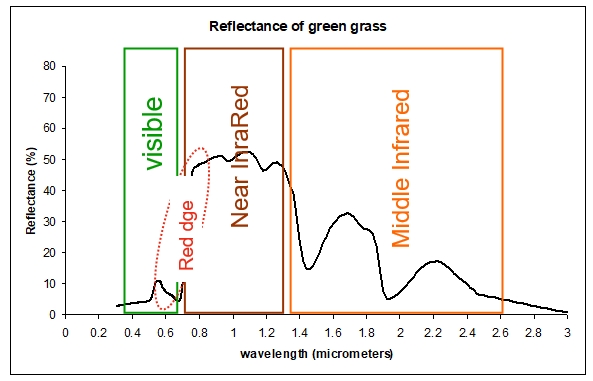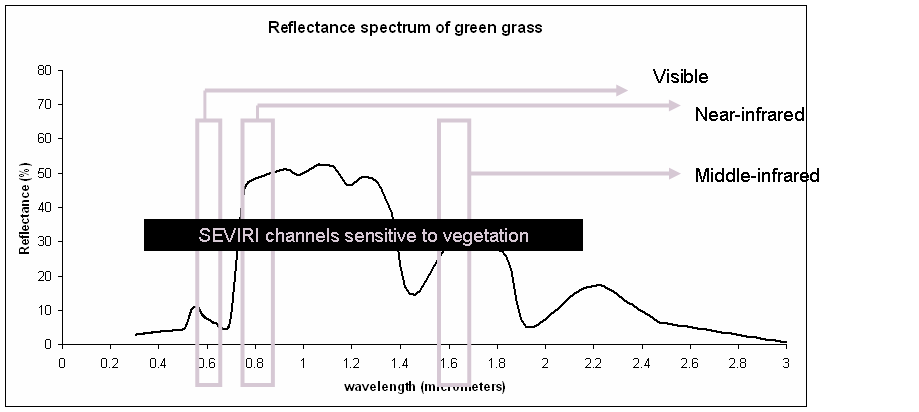Chapter III: Satellite sensors and vegetation
3 - Satellite sensors and vegetation
In this chapter we will detail how vegetation interacts with radiation. We will first see how to distinguish between vegetated and non vegetated surfaces using some broad features that are spectrally separable. Then we will emphasize on how spectral resolution is used to distinguish between different species of vegetation, different phases of the life cycle of plants and vegetation stress. Finally we will describe the satellite sensors suitable to retrieve information from vegetation surfaces.
3.1 - Spectral response of different surfaces
As already mentioned in chapter 2.3 different surfaces have different reflectance spectra. Vegetated and non vegetated surfaces can be recognized by some distinctive broad feature types:
Vegetated surfaces
Beyond 1.3μm, vegetation essentially absorbs or reflects the incident radiation; transmittance is negligible and the dips in the reflectance spectra correspond to absorption at those wavelengths.
Figure 3.1: Reflectance spectrum of green grass.
Non vegetated surfaces
The reflectance curve of non vegetated surfaces (in the figure it is exemplified by sandy soil) has smaller dependence on wavelength. Some of the factors affecting soil reflectance are moisture content, soil texture, surface roughness, presence of iron oxide and organic matter.
Figure 3.2: Reflectance spectrum of sand.
3.2 - Fundamental factors affecting vegetation reflectance
A typical reflectance spectrum of a vegetation canopy can be subdivided into 3 parts, visible (0.40 - 0.70 μm), near infrared NIR (0.701 - 1.3 μm) and middle-infrared (1.301 - 2.5 μm). Another optical property of the reflectance spectrum of vegetation is the abrupt transition between the strong absorption in the visible red and the strong reflectance in the NIR domain known as Red Edge.
Figure 3.3: Reflectance spectrum of green grass subdivided into the 4 main optical properties of the reflectance spectrum of vegetation.
NOTE: The classification of the electromagnetic radiation used in this module is the most widely used in the vegetation community. The Visible is within the interval 0.40 μm - 0.70 μm; the Near Infra-red 0.701μm - 1.3μm and the Middle Infra-red 1.301μm - 2.5μm. Thus, in this module, channel 0.6μm is called Visible (VIS); channel 0.8μm - Near Infra-red (NIR) and 1.6μm - Middle Infra-red (MIR), instead of the classification used in the Satellite Meteorology community 0.6μm - Visible (VIS), 0.8μm - Visible (VIS) and 1.6μm - Near Infra-red (NIR)
3.2.1 - Visible region
The visible part of the reflectance spectrum (0.40 μm - 0.70 μm) of vegetation is controlled by the pigments in the green leaf chloroplasts that reside in the outer or Palisade leaf, the Chlorophyll pigments - chlorophyll-a and chlorophyll-b. A pigment is any substance that absorbs light. The colour of the pigment is determined by reflected wavelengths. White pigments/light colours reflect all or almost all of the energy striking them. Black pigments absorb all of the wavelengths that strike them. Chlorophyll is the major absorber of radiation in the visible region and its absorption is dominant in the visible red 0.6 - 0.7 μm - red wavelengths; it is called the green pigment and it is common to all photosynthetic cells. Other leaf pigments also have an important impact on the visible part of the spectrum. The carotene (yellow to orange-red pigment responsible for the colour of some flowers, fruits and leaves without chlorophyll) and xantophyll (responsible for the leaf colour in autumn) have strong absorption in the 0.35 - 0.5 μm, blue wavelengths.
Figure 3.4: Reflectance spectrum for green grass, for VIS wavelengths.
Figure 3.4. shows a typical reflectance spectrum for green vegetation, for VIS wavelengths. Since absorption occurs in red and blue wavelengths, the predominant reflectance of visible wavelengths is concentrated in the green.
3.2.2 - Near infrared (NIR)
The optical properties in the near infrared spectral domain (0.701 - 1.3 μm) are explained by leaf structure. The spongy mesophyll cells located in the interior or back of the leaves reflects NIR light, much of which emerges as strong reflection rays. The intensity of NIR reflectance is commonly greater than most inorganic materials, so vegetation appears bright in NIR wavelengths.
Figure 3.5: Reflectance spectrum for green grass, for NIR wavelengths
3.2.3 - The red edge
The red edge is a region in the red-NIR transition zone of vegetation reflectance spectrum and marks the boundary between absorption by chlorophyll in the red visible region, and scattering due to leaf internal structure in the NIR region. This transition zone is in the basis of several vegetation indices like NDVI which is the normalized difference between the reflectance in the red visible (0.6μm) and the NIR (0.8μm) reflectance. Also the red edge position (REP) is used to estimate the chlorophyll content of leaves or over a canopy.
Figure 3.6: Reflectance spectrum for green grass, for the transition zone between VIS and NIR wavelengths- the Red Edge
The concept of Red Edge is on the basis of the most widely used vegetation index - the Normalized Difference Vegetation Index (NDVI). This index is the normalized difference between the NIR and the red VIS reflectance.
Where ρ NIR and ρred are the reflectance values for NIR and VIS (red) bands, respectively.
This combination of the strong absorption in the red visible and strong reflectance in the NIR is very specific of vegetation and allow us to distinguish vegetation from bare soil (see Figures 3.1. and 3.2). Calculations of NDVI for a given pixel can always result in a number that ranges from -1 to +1; however, for natural surfaces NDVI values are within the 0 to +1 range. An NDVI close to 0 corresponds to no vegetation, while NDVI close to +1 (0.8 - 0.9) indicates the highest possible density of green leaves. NDVI can be computed at the Top Of the Atmosphere (TOA) or at the surface, i. e. using atmospherically corrected reflectances for NIR and Red bands.

Figure 3.7: NDVI daily composite of SEVIRI full disk, June 15, 2008 (extracted from Yu,Y. et al. Development of Vegetation Products for U.S. GOES-R Satellite Mission, Presented on 4th Global Vegetation Workshop Univ. of Montana, Missoula, June 16-19 2009 )
3.2.4 - The middle-infrared region (MIR)
The middle-infrared region (1.301 - 2.5 μm) contains information about the absorption of radiation by water, cellulose and lignin and several other biochemical constituents. ( For further information see for ex. Curran,1989).
Figure 3.8: Reflectance spectrum for green grass, for MIR wavelengths
This region of the vegetation spectrum allows the identification of vegetation stress due to drought.
3.3 - The importance of spectral resolution
In the previous section we saw that the spectral characteristics of the vegetation spectrum are related with the leaf pigments, leaves internal structure and water content within leaves. A close analysis of the vegetation spectral reflectance provides information on the phase of vegetation life cycle, health, and even the identification of individual vegetation cover types.
3.3.1 - Distinguishing among different life cycle phases
When a plant undergoes senescence, chlorophyll is no longer produced, and other pigments present in plants become visible.
3.3.2 - Vegetation stress
Following changes in vegetation, and therefore in foliar chemistry and membrane structure, the vegetation spectral signatures may be substantially modified. Stress is indicated by a progressive decrease in near-Infrared reflectance accompanied by an increase in middle-Infrared reflectance (See Figure 3.9).
Figure 3.9: Reflectance spectrum of healthy and stress sugar beets (Kyllo, 2003).
3.4 - Satellite sensors sensitive to vegetation
Given the interaction between vegetation and radiation analysed throughout the previous sections, the monitoring of vegetation requires sensors with bands/channels within following domains: VIS, NIR, MIR.
Figure 3.10: Bands/channels suitable to retrieve vegetation information.
For detailed information about the different sensors used to retrieve vegetation parmeters please consult Satellite Operator - spectral channels.doc
3.5 - RGB images
RGB images can be used to extract information about vegetation cover. RGB techniques work by associating a colour to a particular channel.To extract maximum information from a single image each colour (Red, Green or Blue) should be associate to a different channel with distinct physical properties.
To extract information about vegetation cover, the RGB composite 1.6; 0.8; 0.6 μm, often referred as "Day natural colours" composite, can be used.
In this composite Red is associated to NIR 1.6 μm; Green to VIS 0.8 μm and Blue to VIS 0.6 μm. So as you can see in the image:

Figure 3.11: Meteosat-9 colour composite image of 1.6 μm, 0.8 μm and 0.6 μm
- Reddish/pink is dominant for bare soil and arid regions.
- Green is the dominant component for vegetation.
- Cyan is evident in ice clouds.
A complete description of how to apply RGB techniques in satellite images and forecasting, can be found in https://resources.eumetrain.org/IntGuide/









